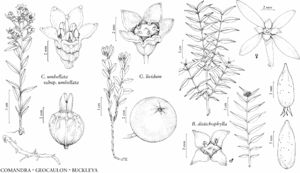Buckleya
Amer. J. Sci. Arts 45: 170. 1843.
| Taxon | Illustrator ⠉ | |
|---|---|---|
 | Buckleya distichophylla Geocaulon lividum Comandra umbellata subsp. umbellata | Yevonn Wilson-Ramsey Yevonn Wilson-Ramsey Yevonn Wilson-Ramsey |
Shrubs, dioecious. Stems hairy. Leaves opposite or subopposite, distichous to decussate. Inflorescences: staminate 1–3 [–5] dichasia, pistillate flowers solitary, subtended by 2 pairs of decussate, deciduous bracts. Pedicels: staminate present, pistillate absent. Flowers unisexual. Staminate flowers: hypanthium absent; sepals 0; petals 4, post-staminal hairs absent; nectary squarish; stamens 4. Pistillate flowers: hypanthium completely adnate to ovary; sepals 4; petals 4; nectary squarish; ovules 3–4 per locule; stigma 4-lobed. Pseudodrupes: exocarp fleshy; pedicels not enlarging or becoming fleshy; sepals accrescent, deciduous [persistent], petals deciduous. x = 15.
Distribution
e United States, e Asia (China), e Asia (Japan)
Discussion
5 species (1 in the flora).
The morphologic nature of the two floral whorls appearing at the fruit apex has received various interpretations. R. K. F. Pilger (1935) referred to the outer whorl as bracts and suggested that they are prophylls from two aborted side flowers of a dichasium. A simpler explanation, followed here, is that the outer whorl represents sepals and the inner whorl petals (F. H. Smith and E. C. Smith 1943; J. P. Der and D. L. Nickrent 2008).
Buckleya is disjunct between eastern North America and Asia. Based on morphologic features such as the deciduous sepals, W. N. Carvell and W. H. Eshbaugh (1982) proposed that B. distichophylla is most closely related to B. graebneriana Diels of China, a hypothesis supported by the molecular phylogenetic analysis of Li J. H. et al. (2001).